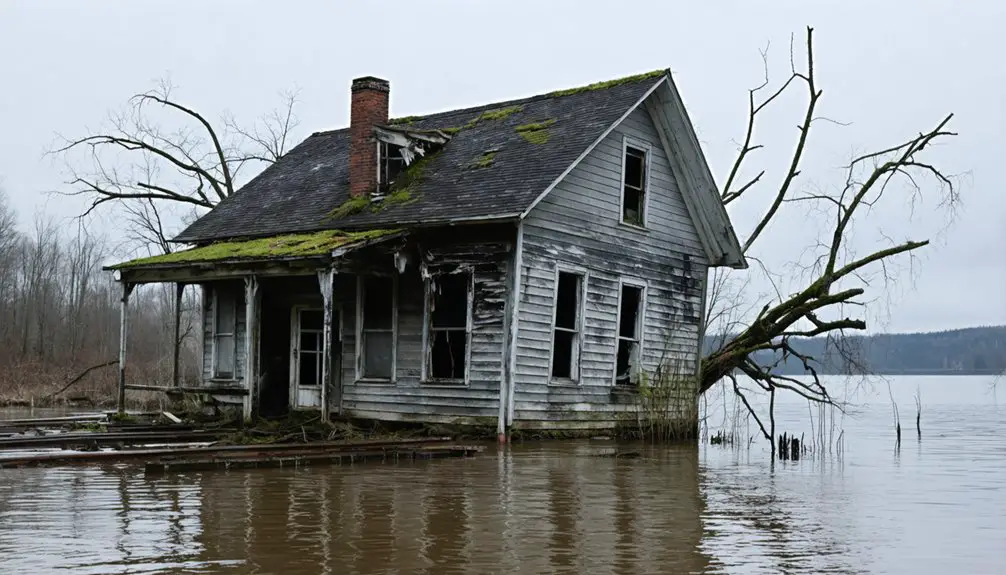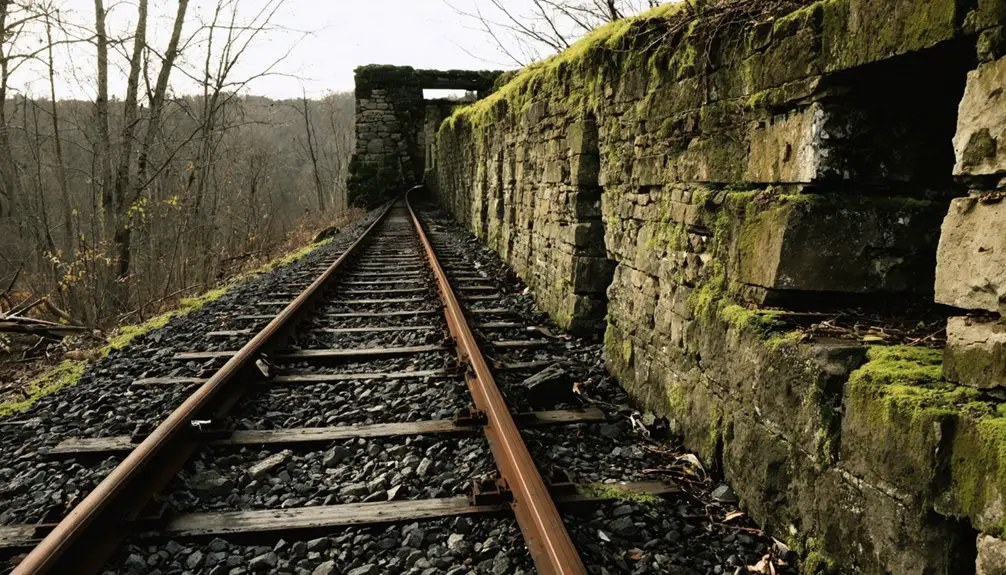You’ll find the submerged remains of Livermore, Pennsylvania’s most notable ghost town, beneath Conemaugh River Lake. This once-bustling canal town, home to 91 businesses by 1876, faced devastating floods in 1889 and 1936 before its final abandonment in 1952 due to the Conemaugh River Dam Project. The area’s rich history lives on through local ghost stories and paranormal tales that connect to both its Native American roots and its watery fate.
Key Takeaways
- Livermore, Pennsylvania became a ghost town after devastating floods, including the 1889 flood that killed over 2,200 people.
- The once-bustling canal town of Livermore contained 91 businesses by 1876 before its eventual abandonment.
- Livermore’s remains now lie beneath Conemaugh River Lake, created by the Conemaugh River Dam Project in 1952.
- Local ghost stories and paranormal sightings are reported near the submerged town site beneath Conemaugh River Lake.
- The town was a major transportation hub from 1827 until floods and the dam project led to its abandonment.
The Formation of Lake Conemaugh
When Pennsylvania sought to expand its canal system in the early 19th century, the state undertook an ambitious project to construct the Western Reservoir between 1838 and 1853.
You’ll find this massive water source, later known as Lake Conemaugh, stretched across 450 acres, reaching depths of 75 feet near its dam.
The reservoir’s purpose was clear: supply water to the Western Division Canal connecting Johnstown to Pittsburgh.
The Western Reservoir served a vital purpose: keeping canal boats afloat on their journey between Johnstown and Pittsburgh.
But you’d be surprised how quickly plans can change. Just as the waterway system reached completion, railroads emerged as the dominant transportation force.
The state sold the property to the Pennsylvania Railroad, who then transferred it to private investors. They transformed this engineering marvel into an exclusive recreational haven, forever changing the reservoir’s role in the region’s history. The South Fork Fishing Club acquired the property in 1879, establishing it as an elite retreat.
The dam stood an imposing 69 feet high, stretching 931 feet across the valley.
The Devastating Flood of 1889
The peaceful waters of Lake Conemaugh held a deadly secret in the spring of 1889. When unprecedented rainfall and melting snow pushed the South Fork Dam beyond its limits, you’d have witnessed nature’s raw power release 20 million tons of water onto unsuspecting communities below. Leading up to the disaster, the region endured 168 days of precipitation throughout the year.
The flood aftermath revealed the devastating scope of this catastrophe:
- Over 2,200 lives lost, including 99 entire families
- Communities transformed into ghost towns overnight
- Railroad lines and communication systems destroyed
- A flow rate temporarily matching the Mississippi River
The disaster response marked a turning point in American history, as Clara Barton’s Red Cross launched its first major relief operation. Nearly 25,000 survivors received assistance through Red Cross relief efforts.
You’ll find it remarkable that aid poured in from 18 foreign countries, demonstrating how this catastrophe united people across borders in unprecedented ways.
Life in Historic Livermore
You’d find Livermore bustling with activity as a canal town along the Conemaugh River, where 91 businesses, including 13 saloons, served the daily needs of locals and travelers by 1876.
The town’s industrial backbone included the Livermore Fire Brick Company and Kaiser Paving Company, which anchored the local economy alongside clothing stores, banks, and the town newspaper. For clarity in historical records, this settlement should not be confused with other place name references to Livermore.
The Pennsylvania Canal’s Western Division and later the West Penn Railroad made Livermore an essential transportation hub, connecting the community to larger markets and supporting its growth as a commercial center. The town’s existence came to an end when it was razed in 1952 to accommodate the construction of the Conemaugh Dam.
Daily Canal Town Commerce
Life in historic Livermore centered around a bustling rhythm of canal commerce, as boats arrived approximately every 20 minutes during peak operations.
You’d find the town’s economic pulse driven by constant freight handling at local docks and warehouses, where crews efficiently transferred cargo between vessels.
The daily scene included:
- Merchant businesses loading and unloading goods from warehouses
- Boat crews frequenting local taverns and inns between shipments
- Workers managing seasonal water levels to keep commerce flowing
- Freight forwarding houses coordinating deliveries of raw materials and manufactured products
The canal’s presence shaped not just commerce but the entire community’s daily routine. The development of the Pennsylvania Mainline Canal in the 1830s transformed Livermore into a vital transportation hub.
From dawn to dusk, you’d witness a steady stream of activity as townspeople, merchants, and travelers participated in this essential transportation network. Today, visitors can see stone abutments from this era when water levels drop at Conemaugh River Lake.
Industrial Business Community Hub
Beyond the steady flow of canal traffic, Livermore’s industrial foundation took root in 1827 when John Livermore established this strategic settlement along the Conemaugh River.
You’d find the town’s industrial heritage thriving through its blast furnaces and the renowned Conemaugh Salt Works, which produced an impressive 500,000 barrels annually at its peak.
As a demonstration of community resilience, Livermore’s modest population of 211 supported a vibrant business ecosystem. The town’s slow canal transport allowed two mules to efficiently haul fifty tons of goods at roughly two miles per hour.
You could’ve walked through town and discovered barrel stave manufacturers, coal mines, and iron ore operations dotting the landscape.
The town’s strategic position between Johnstown and Pittsburgh made it an essential hub where industrial workers, merchants, and tradespeople converged.
Multiple churches shared facilities, while local stores, a school, and a bustling hotel kept the community connected.
River Transportation Networks
While the Pennsylvania Canal system stretched an impressive 103 miles from Johnstown to Pittsburgh, Livermore’s strategic position along the Conemaugh River made it an important transportation hub in 1827.
The canal infrastructure transformed river commerce, with locks positioned every two miles to manage water levels and enable smooth navigation. Under the guidance of engineer Alonzo Livermore’s expertise, the locks were modified with larger dimensions to accommodate increased river traffic.
You would’ve witnessed these remarkable developments in transportation:
- Canal boats floating above streams on innovative aqueducts
- Lock systems masterfully handling a three-foot water level drop per mile
- The West Penn Railroad station’s arrival in 1864, connecting to Blairsville and Saltsburg
- Integration of stores, churches, and schools supporting the transportation network
The town’s position along both canal and rail routes created a significant link in the region’s transportation evolution, showcasing engineering innovation and commercial growth through the early 1900s.
The Great St. Patrick’s Day Flood

You’ll find few events more catastrophic to Conemaugh’s history than the Great St. Patrick’s Day Flood of 1936, when melting snow and torrential rains released devastating waters upon the town.
East Conemaugh’s railroad engineer John Hess became a local hero when he used his locomotive whistle to warn residents of the approaching flood, though approximately 50 lives were still lost as passengers became trapped in stranded trains.
The town’s recovery efforts stretched on for years, with major flood control projects implemented between 1938-1943 to prevent future disasters of this magnitude.
Devastating Waters Break Free
After enduring a harsh winter with 63 inches of snowfall, Conemaugh and its neighboring communities faced catastrophic flooding in March 1936 during what became known as the Great St. Patrick’s Day Flood.
As temperatures rose to 50°F, rapid snowmelt combined with relentless rain released nature’s fury on the narrow valley.
You’ll discover the flood’s devastating impact through these haunting details:
- Floodwaters appeared like “a huge hill rolling over,” carrying deadly industrial debris
- Engineer John Hess’s heroic warning saved lives with his locomotive whistle
- East Conemaugh lost 50 residents to the surging waters
- The community suffered over $43 million in damage to homes and businesses
The flood aftermath revealed both devastating loss and community resilience, forever changing Conemaugh’s landscape and leading to essential flood control measures.
Town Struggles to Rebuild
Despite the immense challenges ahead, Conemaugh’s resilient community launched into action following the devastating St. Patrick’s Day Flood. You’d have witnessed remarkable community resilience as firefighters and railroad workers helped evacuate stranded citizens and managed bridge access during rising waters.
The recovery challenges were formidable. Downtown businesses faced prolonged utility outages, while industrial facilities like the Cambria Iron Works suffered both flood damage and dangerous boiler explosions. More than 135,000 people needed temporary shelter and relief assistance.
The town’s infrastructure took massive hits – streetcar service ended permanently, and bridges lay in ruins.
But you’ll see how determination prevailed. Federal support through the 1936 Flood Control Act brought new dams and reservoirs, while local rebuilding efforts gradually restored homes, businesses, and community spirit.
Paranormal Tales From the Valley
While many ghost towns harbor tales of supernatural occurrences, Livermore’s paranormal stories stand out for their unique blend of Native American lore and demonic encounters.
You’ll find the most chilling paranormal sightings along the West Penn Trail, where two distinct entities reportedly roam the abandoned railroad tracks.
- A menacing demon-like creature stalks nighttime visitors, moving on its knuckles with glowing red eyes
- The protective spirit Monogehelian, adorned in traditional buckskin and shells, eternally pursues this dark entity
- Ghostly encounters often occur near the submerged town site, now beneath Conemaugh River Lake
These supernatural tales connect directly to the land’s Native American history and the town’s tragic flooding.
The stories persist as powerful reminders of both Livermore’s indigenous past and its eventual destruction by natural forces.
The Conemaugh River Dam Project

The construction of the Conemaugh River Dam in 1952 marked a pivotal moment in Pennsylvania’s flood control history. You’ll find this impressive concrete gravity dam standing guard over the Conemaugh Valley, protecting countless communities from devastating floods. Since its completion, it’s prevented over $582 million in flood damages.
You can trace the dam’s greatest achievement to 1972 during Tropical Storm Agnes, when it stopped $2.5 billion in potential destruction and kept Pittsburgh’s Point State Park from being submerged under four feet of water.
The dam’s design maintains a reservoir capacity of 355,000 acre-feet, though it typically holds much less to prepare for sudden floods. In 1989, they added a hydroelectric plant downstream, generating up to 16 megawatts of clean energy while continuing its crucial flood prevention mission.
Ghost Town Trail and Heritage Tourism
Along the scenic Blacklick Creek corridor, you’ll discover the 46-mile Ghost Town Trail stretching through Indiana and Cambria Counties, Pennsylvania. Established in 1991, this National Recreation Trail preserves the cultural heritage of abandoned mining communities while offering year-round outdoor activities.
- Explore remnants of coal mining ghost town attractions like Claghorn, featuring historic iron furnaces and coal tipples.
- Navigate dual-numbered trail markers as you cycle, hike, or ski through this former railroad corridor.
- Connect to Duman Lake County Park for additional recreation and fishing opportunities.
- Experience preserved railroad mileposts and industrial ruins alongside interpretive signage.
The trail’s rich industrial archaeology and striking natural landscape create an immersive journey through Pennsylvania’s coal mining heritage, making it a premier destination for both history enthusiasts and outdoor adventurers.
Engineering Against Nature’s Force

Beyond the recreational trails that now define Conemaugh’s landscape lies a sobering engineering story of humanity’s struggle against nature’s raw power.
You’ll find that South Fork Dam‘s tale reveals the limits of engineering resilience against extreme weather events. Despite its initially sound location with solid rock abutments, the dam faced mounting hydrologic challenges that would ultimately prove insurmountable.
When 6-10 inches of rain fell in just 24 hours, the dam’s compromised design couldn’t withstand nature’s fury.
You can trace how critical modifications, including the lowering of the dam’s crest and inadequate spillway maintenance, created vulnerabilities.
Even desperate last-minute efforts to prevent disaster – unclogging spillways and digging emergency trenches – proved futile against the overwhelming force of 16 million cubic meters of water.
The Last Days of a River Town
Prior to its devastating transformation by the 1889 flood, Conemaugh thrived as a bustling industrial hub where immigrant laborers, coal miners, and steelworkers forged prosperous lives along the river’s edge.
You’ll find the river town history etched in both triumph and tragedy, where community resilience faced its ultimate test. The town’s final chapter unfolded dramatically when the South Fork Dam failed, forever altering Conemaugh’s destiny:
- Homes and businesses were stripped to bedrock as a wall of water and debris tore through the valley.
- Railroad infrastructure, once the lifeline of commerce, became twisted wreckage.
- Industrial facilities, including essential steel operations, were devastated beyond recovery.
- Surviving residents faced displacement as the town’s economic foundation crumbled.
The flood marked the end of Conemaugh’s industrial golden age, transforming a vibrant community into a cautionary tale of nature’s power.
Frequently Asked Questions
What Indigenous Tribes Originally Inhabited the Conemaugh Valley Region?
You’ll find the Shawonese and Delaware (Lenape) were the primary Native tribes establishing their cultural heritage in the Conemaugh Valley, with additional regional tribes maintaining smaller populations throughout the area.
Are There Guided Tours Available to Explore the Underwater Ruins?
While you might yearn to explore Conemaugh’s historical underwater ruins, there aren’t any guided tours available due to dangerous river conditions, scattered debris fields, and strict environmental protection regulations.
How Many Other Ghost Towns Exist Along the Conemaugh River?
Along the Conemaugh River, you’ll find at least nine ghost towns, including Livermore, Social Hall, Cokeville, Fillmore, and several coal mining communities like Shanktown, Scott Glenn, Robindale, and Snyder.
What Was the Average Population of Livermore During Its Peak?
Ever wonder about Livermore’s heyday? During its peak population years in the 1870s and 1890s, you’ll find census records showing 211 residents, though local records suggest higher numbers around 830 people.
Did Any Structures From Old Livermore Survive the Dam Project?
You won’t find any original structures from Livermore today – the dam impact was complete. While historical preservation efforts documented the town’s layout, everything was either demolished or submerged under the Conemaugh reservoir.
References
- https://www.theroadlotstraveled.com/pennsylvanian-horror-story-johnstown-flood/
- https://en.wikipedia.org/wiki/Livermore
- https://pittsburghghosts.com/livermore-pennsylvania-ghost-town/
- https://en.wikipedia.org/wiki/List_of_ghost_towns_in_Pennsylvania
- https://www.conemaugh.org/discover-johnstown-and-the-laurel-highlands
- https://www.heritagejohnstown.org/attractions/johnstown-flood-museum/flood-history/the-club-and-the-dam/
- https://en.wikipedia.org/wiki/Johnstown_Flood
- https://thehistorybandits.com/2016/01/08/disaster-on-the-conemaugh-the-johnstown-flood-of-1889/
- https://www.heritagejohnstown.org/education-materials/flood-museum-materials/the-johnstown-flood-of-1889/
- https://damfailures.org/case-study/south-fork-dam-pennsylvania-1889



